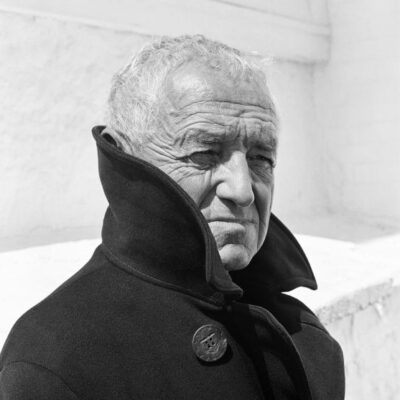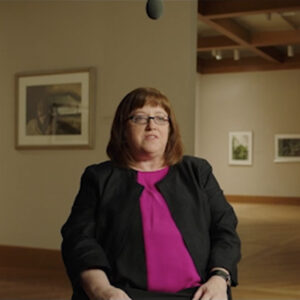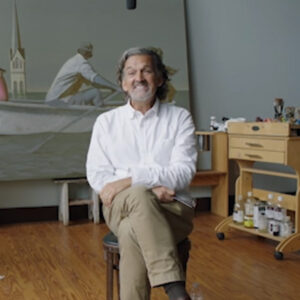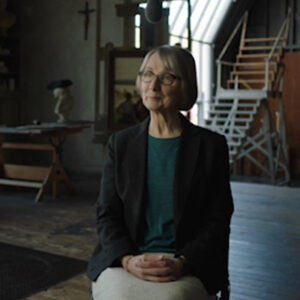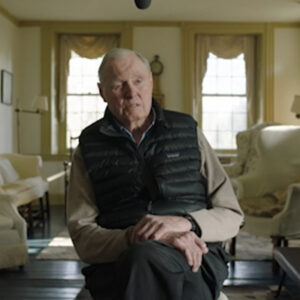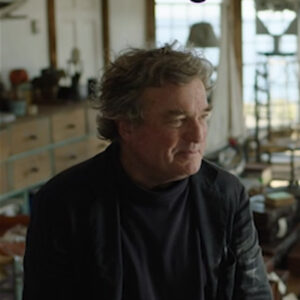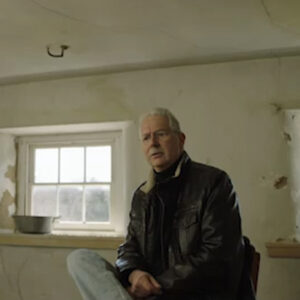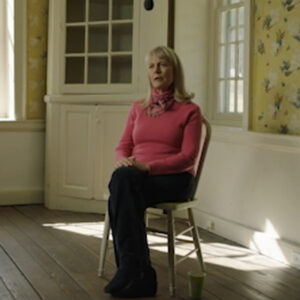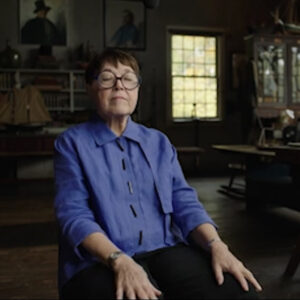Speaker I’m Michael Cohen. I’m chief curator at the Farnsworth Art Museum, and part of what I’m responsible for is the Olsen house here in Cushing.
Speaker So can you talk to me about introduce the auction house to us and let us know who why it’s so important and who lived here and what painter?
Speaker The Olsen house’s history goes back to the 18th century when it was constructed by members of the Hawthorne family who lived here for several generations. One of them married an Olson and hence its name today, known as the Olson House. Its importance stems almost entirely from the fact that Andrew Wyeth, one of America’s foremost painters, did some three hundred works here over the course of 30 years during his career, and the most famous of which is Christina’s world, his iconic nineteen forty eight painting.
Speaker So we’re going to we have from both Nicky and Jamie the circumstance on how he met Christie, could you tell me a little bit about who? Because you had the fact that Kristina lived here with her brother and but sort of days were.
Speaker And he first met the Olsson’s on his first date with his soon wife to be Betsy James, and that began three decades of a friendship with both Cristina and Elvira Olsen, a brother and sister, neither of whom who ever married and who lived their entire lives here. I think what inspired him was certainly the people of our own, Christina, but the world that he saw here in this coastal spot in Maine and the pictorial possibilities that existed not just with this with the people, but with the place and its surroundings.
Speaker When we walked in, we talked about the house and the light and the physician who spoke to me about that, like why it’s so filming the house that we see today is physically much the same as it was when Andy Wyeth came here.
Speaker It’s changed somewhat. And interestingly, the experience for visitors here since it opened in nineteen ninety one is in some ways even more powerful than the house that Andy experienced here. And the reason is that it’s empty, it’s sparse. There’s a sense of the Olsson’s lives here and the spectacular setting on which the house rests. But there’s something special about the way light enters and. It’s something special about the way light let me think about this. There’s something special about the way light transforms the character of the interior of this house. That’s certainly something that Andy took advantage of. And the other thing is that because of its setting high on this hill overlooking the water, there are absolutely stunning views and peaceful ones, given how relatively isolated the Olsen house is here on the Cushing Peninsula.
Speaker Could you talk to me about what you know about Christina and the fact that she was she had to move around the house in a different way than you and I were around? Yes, that sort of.
Speaker One of the. Let me think about how to introduce this.
Speaker Kristina Olsen suffered from a still not entirely diagnosed, debilitative neurological disease that gradually over decades deprived her of the ability to walk. But by all accounts, she was a stubborn and proud woman who refused to use a wheelchair and towards the later years of her life, literally had to drag herself around inside and outside the house. That’s awfully hard to imagine a life like that, but that’s the life that she chose to live.
Speaker And that’s the that’s the constituency on the Hill.
Speaker Yes, Christina’s world and these famous painting was inspired by a view he got from the upper floors of the house, looking out a window into the field, which is part of the Ellson House farm. And there he saw Christina out in the field and crawling towards the house.
Speaker I wonder after you’ve been here for a while, you know the story you know so well on the painting so well, why do you think that painting sort of became sort of part of America’s consciousness? What is it about that? In your opinion? Yes. What do you think clicked?
Speaker Andy was Christina’s world is an iconic work in American art, it’s well known not just in America but in many parts of the world. And a puzzling question to me is why exactly did that happen? And I don’t really have an answer for that yet. We have the comments of visitors to the House over decades now who respond much in the same way I did on my first visit. It’s a it’s a special place, but the impact of the painting is something else entirely different. He altered his observation of the house from down on the field. What you see in the painting is really not an accurate depiction of where the barn is in relation to the house. The field is stripped of all trees and foliage, which was there and still is here today. But that kind of artistic license is, of course, to be expected with any artist. The thing that intrigues me most is what did people actually know about the subject when they first saw this painting? And we can’t look at it today without knowing the story of Christine Olson and her, you know, and her stubbornness and her pride and the challenge she faced with every aspect of everyday life due to her disease. But I don’t know what someone in nineteen forty eight would have known about her when they first saw that painting. I don’t know yet what Alfred Barr, who acquired it for the Museum of Modern Art, actually knew about the subject. It’s intriguing that it is attracted so much attention over decades now since it was painted.
Speaker But exactly why it does is still something of a mystery to me that the fire on Earth. Well, I mean, there be many more.
Speaker There you go. I said, oh, God is a guy across the field going right now, moving on.
Speaker OK, so I can feed market.
Speaker So could you talk to me about Andrew, where anything and what his relationship was like, he’s kind of comfortable here with me and he spent part of every summer here for almost 30 years.
Speaker And the things that he chose to paint here very because of the things he chose to paint here varied over time. Of course, he depicts both Alvaro and Cristina. He depicts various rooms and views from various windows in the house, and he depicts views outside looking towards the house and occasionally away from the house. I think like his work in Chadds Ford, he was intimately connected to the landscape and in this case, intimately connected to the place because of his friendship with Alvaro and Cristina. It was some kind of comfort zone to him, I think. And he often returned to places that attracted his attention as an artist, the kind of visual opportunities that existed in front of him. He spoke often of having really to be captured by a scene in front of him to be willing to start committing it, either pencil and paper or to watercolor or dry brush on paper. There had to be something that really grabbed him.
Speaker And it’s so interesting to me that in both places he would he would repeat visits over and over again like he was continually interesting. And that’s what’s interesting to me.
Speaker Yes, I think it’s that if something really grabbed him, it often seems that he’s going to extract every bit out of that opportunity over time. Not necessarily all at once.
Speaker So I think you had mentioned and correct me if I’m wrong, that he actually made a room upstairs, a studio. Is that true?
Speaker Yes, Andy, thanks to the Olson’s generosity, they gave Andy pretty much free run of this place. So he set himself up a little studio upstairs to work. I mean, you didn’t require a lot an easel, paper, brush, water and the paints that he would use. He wasn’t an oil painter and Tempora paintings, which he did far fewer of than watercolors and dry brush painting were things that he did in his studio they took months to do, whereas the drawings and watercolors and dry brush were the kinds of works that he could do things much more quickly. And in fact, the medium almost demanded it.
Speaker When you look at the work that he’s done here and then you walk through the space, what are the sort of things that are a few through his artwork? Ask that question again, would you? Do you know about the physical place and the artwork? Yes. So I’m sort of interested to hear your view of different experiences. Does he see things differently than they really are? Has he depicted a different world or has he really been true to the physical environment?
Speaker For the most part, and he’s been for the most part, and he has exhibited fidelity in his observations that spur his interest in doing a work of art whose subject is the Olsen house in one fashion or another. The thing that struck me about this place is I came here about 15 years ago for the first time, and of course, I knew Andrew Wise work. I had visited the the Brandywine River Museum shortly after it opened. So I was struck by the work that Andy did that depicted that part of his world. It’s and it’s a beautiful part of the United States. But I came here and the experience I had has told me a lot about why people come here and keep coming back. I walk through the house on a beautiful summer afternoon. The sun was shining. It’s quiet here, peaceful. The house is relatively isolated from other houses here on the peninsula. But walking through the house, it was the feeling that the spaces and the light inside them. That really grabbed me, as I’m sure it did him, but I can tell you that not once that I think of any specific work that Andrew Wyeth did here, that’s not what the place was about for me. I’m sure it was the same kind of experience he had and coming into this house. The other thing that I’m sure most visitors don’t know and really couldn’t be expected to know is that the house you see today, although physically largely the same as the one Wyeth experienced here, when you’re inside, you don’t see the house the way the Olsson’s lived here. The Elson’s were poor. They were sustenance farmers. One of these two people was disabled every day. Life was an extraordinary challenge, the likes of which most of us do not experience. What Andy chooses, understandably not to depict, is the kind of social commentary that other artists might have chosen. He does not really reveal the depth of poverty and physical labor that were part of everyday life here. Part of it, I think, is a respect for the people who are his friends. And he wasn’t going to delve into that sort of depiction of their lives and world here. But other people who came here commented on it. The other thing that has transformed the place since the Olsson’s death in 1967 and 68 is that the house was in 1969, I think bought by Joseph Alibiing, famous Hollywood producer who had thirty six works by Andrew Wyeth and who was enamored of Wyatt’s work and. Sought to create a kind of museum in which to show Andrew Bias works, including his own, which did happen in 1970, but when he bought this house, it was a wreck, an absolute wreck. Holes in the ceilings, holes in the walls, filthy, dirty, peeling wallpaper. That’s not what a visitor sees here today. So what is it that they do? See, what Levine chose to do was to renovate the house. It had to be renovated in order to make it visible, not habitable, but visible. They installed electricity, but the physical changes involved, of course, making all the repairs to the broken down interior. That’s one thing. And it was in many places completely repainted to create.
Speaker A stark white interior, sparse.
Speaker That really recalled the character of Andrew Wyeth’s interiors, the ones he depicted in his work not just here, but also in Chadds Ford. It became a kind of stage set in which the show and these work in a very effective one. And the reason this happened was in part because of Levine’s engagement of Betsy Wyeth to help create a new environment in which to show Andrew Wyeth works. That is the house that you see today, largely one that’s been made. A kind of replica in a way, of the things that interested Andrew Wyeth and depicting interiors of old houses, which he did often.
Speaker That was a really great story. Yeah, it’s one that I learned here.
Speaker I’m wondering if we could take a step back. Yes, just the very beginning. Yes. Your comfort level seems a little bit lower. Yeah, of course. So you just sort of locate this house for us.
Speaker Where are we? Where does this house in Maine and what sort of like around what was around here in the US?
Speaker Yes, living the old house sits atop a hill overlooking the water and the Cushing Peninsula. Cushing is about 12 miles from Rockland where the Farnsworth Art Museum is situated. The Olsson’s. Take a second. The Olsen house was a saltwater farm. There were blueberries here. They grew some crops. They had chickens, a few other animals. And Elvira was a fisherman, too. This was the way he supported himself. And his sister was the hard work involved with both agriculture and fishing in a barter economy, the house said on dozens of acres. And originally they had a completely unobstructed view from their front door of the water all around them. It was quite a setting and one in which many people saw for the first time from the water, and when one stands down at a certain point today and looks back up at the house, you get a pretty powerful sensation of what this place would have looked like from the water. Remember, too, that it was originally white, as most every farmhouse in Maine would have been in the 19th century when this place was reconstructed around 1873, raising it from a two story to the present three story structure. The architectural style chosen was Greek revival, which was long past its popularity almost every place except perhaps Maine. So this grand house of three stories with dormer windows looking out towards the water was like a white beacon on the hill.
Speaker Let’s talk a bit about the secretary, yes, who is buried there and whom have you had conversations about the cemetery with Jamie and Nikki?
Speaker I will. OK, it’s not ours, that’s all. I just have to be a little sensitive. We don’t direct people there. We can it’s not our property. But neither the wise nor the oceans are concerned about that.
Speaker So I can gladly I can talk about it. If you just talk about the proximity to that. Yeah, yeah, yeah. And we definitely want that part of our agenda to talk with you. Yeah. Yeah. Good. So you tell me about the cemetery down the road apiece.
Speaker Well, the Olsen family’s been here for generations and hence, like many families who have been in the same place in Maine for generations, they have their own cemetery. And down there is where Alvaro and Christina and others from their family who preceded them are buried. And that is a place where Andrew Wyeth is buried as well. And it sits right on the edge of the water beyond the spot where Christina was when Andy saw her and for the inspiration for his Christina’s world painting. So it looks back towards the house where Christina was and, of course, where the house is today.
Speaker So I was stunned when he chose to be very surprised, a lot of people, I think, yeah, there’s a drawing in the book that you had. Yeah. That has its own last drawings. Christine is grave and it’s got this black marker that looks like his marker.
Speaker So it is his. Yeah. Yeah. I don’t know the answer why he chose that stone. Interesting talk to me about why why this place is worth preserving. I mean, why not sell to a developer and make condos? It’s a great.
Speaker Well, the importance of this house is clearly because one of America’s most famous and most admired artists did nearly three hundred works here over 30 years, I can’t think of any house associated with an American artist that has that kind of legacy. It’s the only reason this place was preserved. It’s not because it’s an architectural gem. It’s not because the interior is a spectacular example of Victorian or some later period of design. It has very few furnishings that the Olsson’s lived here with. It’s basically empty. The story is Andrew Wyeth. And the story is not just Christina’s world, but it certainly revolves around the painting that helped establish Andrew Wyeth career as a relatively young artist. It was a big deal for an artist to have a work acquired by the Museum of Modern Art. And today, it’s still there. It’s here today, the challenge of preserving it is a significant one. It’s a national historic landmark. So it places that that designation places it among America’s most.
Speaker And for that, Heidi. Yeah. Yeah.
Speaker Volson House is a national historic landmark, and the reason it’s a landmark is because of the work of one of America’s most important artists did over a 30 year period. I really can’t think of another building that has that kind of story that it inspired so much work and important work by such an important artist. That’s the reason it’s here. And it’s the almost the only reason that it’s here. It’s an ordinary house. Architecturally, somebody could have come along when it was being sold and renovated and made it livable and there would be a two car garage and there’d be a basement here, or it might have been knocked down completely and sold for development. In fact, part of the ohlson properly, in fact, part of the Olson’s original farm property was undergoing a plan for development. And fortunately, that didn’t happen. You still have this beautiful, peaceful setting overlooking the water when you stand at the front door of the Olsen house.
Speaker So we’re going to hear history. Yeah, yeah. This is probably not for the documentary here today. Yeah, yeah. What will people experience if they come here? Yeah. So the visitors. Yeah. Yes.
Speaker The story we tell here is about Andrew Wyeth and the work that he did here. If you come to the Olsen house as a visitor, your tour begins outside to get a sense of where this place is and the beautiful views that you experience here and the sense of the land that provided the OLSSON’S with you could call it a livelihood, but it’s really a means of of living here. The tour then brings a visitor inside to tell the story of the work that was done by Wyeth here. We have reproductions of some of his work here in the places that show you exactly what he was looking at and what he depicted. What we hope happens here is that a visitor gets a sense of what inspired Andrew Wyeth, but we also want to make sure that visitor has a chance to explore the place on them. We want to give excuse me. We want to make sure that a visitor has a chance to explore the House on their own to do what it was that I did when I first came here. Just be here, because that’s really a powerful experience. And in a way, I think it does tell you something about what intrigued Andrew Wyeth.
Speaker I think so. I guess what you said earlier, the light is everything. Yeah, yeah.
Speaker I mean, I’ve got a great view looking back into the shed behind you there as the light hits that rickety rotten floor.
Speaker Could you just talk a little bit about that? Kind of. Yeah, just hear about the light and how it moves through the spaces. Yeah. And you see through doorways and windows and. Yeah.
Speaker You think how to begin that?
Speaker Let’s continue. Yeah, well, the experience of the House is one that evolves with the time that you have to spend here. There are so many rooms and doorways through which one can look and experience another space. There’s a sense of anticipation going from one to the next. You’re constantly interrupted. And the most enjoyable of ways with the view is out the windows. There are thirty six windows in this house on three floors. You see the spectacular setting. You see the places where Andrew Wyeth walked and set up his sketchpad or his watercolor pad. You see where he worked. I mean, you can literally follow his footsteps here.
Speaker It was perfect.
Speaker OK, which we’re doing. Yes. So I feel great about that. And I have that’s what you want to share with us that you like to share with people about this that I haven’t.
Speaker You know, the reason it’s a historic landmark is an important one. Obviously, we’ve covered Andrew and all the work that he did here at Christina’s world. That’s nice of you to ask about the visitor experience, because that’s not something that gets talked about regularly. You did ask something before we started, though, about the sort of the Chadds Ford and and Cushing thing and that might be worth talking about.
Speaker So it’s turning into this sort of like. Yeah, yeah. Yeah. Do you want to talk to about your reflections? Yes.
Speaker We’ve been talking a lot about the work that Andrew Wyeth did here at the Ellson house. It wasn’t the only place he painted a long MidCoast, Maine, Port Clyde, obviously, where he lived in the house that his father bought and other places on the MidCoast, as it’s known. What’s interesting is that Andy did. The same kind. Now, what’s interesting is that Chadds Ford was equally, if not more important, Andrew Wyeth and I say more because he spent more time there. It was nine months a year in Pennsylvania and three months a year in Maine, roughly speaking.
Speaker But the thing that.
Speaker One thing that stands out about Andrew Wyeth’s work, in contrast to the work of most of his contemporaries, is that he grew up and lived in two places and two places alone during a long and productive life as an artist, Chadds Ford, Porchlight and Cushing. He was in no way a product of an urban world. He studied with his father. He was home schooled, so the places that his that define his life were these two rural communities. And if you look at almost any of his contemporaries, wherever they may have been born and raised, their careers were initiated by working and studying almost always in New York City, sometimes other cities in the country. But New York was the center of the art world, still is in the United States. That was not Andy’s world. If you think about someone like Edward Hopper, who Andy knew and whose work he respected, what are the works you think of by Edward Hopper, another great 20th century American artist? It’s Nighthawk. It’s this emotional, isolated view of life in New York City. Yeah. Skip all that. I want to get to where you go.
Speaker No, I don’t like where I’m going. That becomes a dissertation in itself. And we don’t need Edward Hopper. The part about Andy being rural as opposed to urban is is a huge, huge thing. Andy was trained by his father. He didn’t experience the kind of competition and engagement and friendship or lack of friendship that came from studying with others of your ilk in New York.
Speaker That really, really sets him apart. And his and the. That really sets them apart and how his life unfolded and hence what his work was about.
Speaker I don’t know if it’s conscious, but it’s just in looking back at it all, it just seemed like he needed an anchor in this house. Interesting. Yeah, Kernis was an anchor. Yeah, they both were.
Speaker I think I’d leave it at that. Yeah, I mean, that that part about Andrew Wyeth’s training and where he lived, it’s not a secret, but I don’t think it’s its impact is as widely understood as it needs to be. I mean, and he wasn’t I don’t know what works of art you saw by his contemporaries. Had no idea. I suppose it’s learnable. But, you know, if you’re Edward Hopper, George Bellows, you’re in the you’re in the thick of it all the time, showing, you know, meeting these people, becoming friends, making enemies among your fellow artists. That wasn’t that wasn’t part of Andy’s life here. I will say these two places provided Andrew Wyeth with a kind of stability, a certainty, a familiarity that really mark the ebb and flow of his daily life for his whole life. I can’t think of any other American artist whose work is so rooted in just two places and almost no others.
Speaker I agree. Yeah, my favorite line that we’ve had in our research and development is that somebody said a long line war and never had to pay an electric bill in the life of daily life that we have now.
Speaker And, you know, things that others can talk about is, you know, the the. The freedom to be and do what he wanted to do was supported by Betsy.

